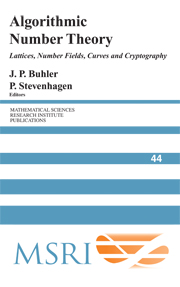Book contents
- Frontmatter
- Contents
- Preface
- Solving the Pell equation
- Basic algorithms in number theory
- Smooth numbers and the quadratic sieve
- The number field sieve
- Four primality testing algorithms
- Lattices
- Elliptic curves
- The arithmetic of number rings
- Smooth numbers: computational number theory and beyond
- Fast multiplication and its applications
- Elementary thoughts on discrete logarithms
- The impact of the number field sieve on the discrete logarithm problem in finite fields
- Reducing lattice bases to find small-height values of univariate polynomials
- Computing Arakelov class groups
- Computational class field theory
- Protecting communications against forgery
- Algorithmic theory of zeta functions over finite fields
- Counting points onvarieties over finite fields of small characteristic
- Congruent number problems and their variants
- An introduction to computing modular forms using modular symbols
Computing Arakelov class groups
Published online by Cambridge University Press: 30 May 2025
- Frontmatter
- Contents
- Preface
- Solving the Pell equation
- Basic algorithms in number theory
- Smooth numbers and the quadratic sieve
- The number field sieve
- Four primality testing algorithms
- Lattices
- Elliptic curves
- The arithmetic of number rings
- Smooth numbers: computational number theory and beyond
- Fast multiplication and its applications
- Elementary thoughts on discrete logarithms
- The impact of the number field sieve on the discrete logarithm problem in finite fields
- Reducing lattice bases to find small-height values of univariate polynomials
- Computing Arakelov class groups
- Computational class field theory
- Protecting communications against forgery
- Algorithmic theory of zeta functions over finite fields
- Counting points onvarieties over finite fields of small characteristic
- Congruent number problems and their variants
- An introduction to computing modular forms using modular symbols
Summary
Shanks’s infrastructure algorithm and Buchmann’s algorithm for computing class groups and unit groups of rings of integers of algebraic number fields are most naturally viewed as computations inside Arakelov class groups. In this paper we discuss the basic properties of Arakelov class groups and of the set of reduced Arakelov divisors. As an application we describe Buchmann’s algorithm in this context.
Daniel Shanks [1972] observed that the forms in the principal cycle of reduced binary quadratic forms of positive discriminant exhibit a group-like behavior. This was a surprising phenomenon, because the principal cycle itself constitutes the trivial class of the class group. Shanks called this group-like structure ‘inside’ the neutral element of the class group the infrastructure . He exploited it by designing an efficient algorithm to compute the regulator of a real quadratic number field. Later, H. W. Lenstra [1982] (see also [Schoof 1982]) made Shanks’ observations more precise, introducing a certain topological group and providing a satisfactory framework for Shanks’s algorithm. Both Shanks [1976, Section 1; 1979, 4.4], and Lenstra [1982, section 15] indicated that the infrastructure ideas could be generalized to arbitrary number fields. This was done first by H.Williams and his students [Williams et al. 1983] for complex cubic fields, then by J. Buchmann [1987a; 1987b; 1987c] and by Buchmann and Williams [1989]. Finally Buchmann [1990; 1991] described an algorithm for computing the class group and regulator of an arbitrary number field that, under reasonable assumptions, has a subexponential running time. It has been implemented in the computer algebra packages LiDIA, MAGMA and PARI.
Information
- Type
- Chapter
- Information
- Algorithmic Number TheoryLattices, Number Fields, Curves and Cryptography, pp. 447 - 496Publisher: Cambridge University PressPrint publication year: 2008
Accessibility standard: Unknown
Why this information is here
This section outlines the accessibility features of this content - including support for screen readers, full keyboard navigation and high-contrast display options. This may not be relevant for you.Accessibility Information
- 5
- Cited by
